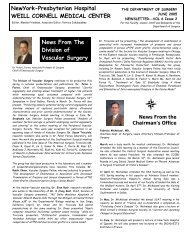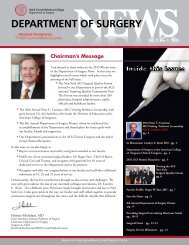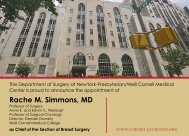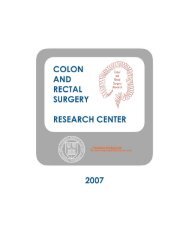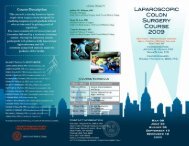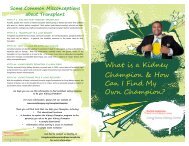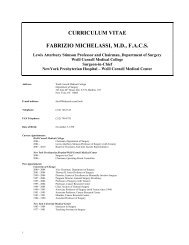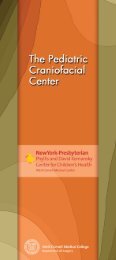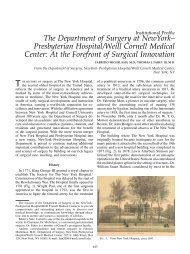Dr. James Gallagher brings pediatric burn center to - Department of ...
Dr. James Gallagher brings pediatric burn center to - Department of ...
Dr. James Gallagher brings pediatric burn center to - Department of ...
Create successful ePaper yourself
Turn your PDF publications into a flip-book with our unique Google optimized e-Paper software.
Mother courage: A woman and her children at Weill Bugando Medical Centre.<br />
Only a lucky few in the nation get appropriate treatment for <strong>burn</strong> injuries;<br />
many others endure a lifetime <strong>of</strong> disfigurement and disability.<br />
3 2 W E I L L C O R N E L L M E D I C I N E<br />
More Than<br />
Skin Deep<br />
On a service trip <strong>to</strong> Tanzania—where <strong>burn</strong><br />
injuries are common and physicians are<br />
few—Weill Cornell surgeons and nurses<br />
aimed <strong>to</strong> help colleagues at Weill Bugando<br />
By Beth Saulnier<br />
Pho<strong>to</strong>graphs by David Chalk<br />
His name was Charles, and he’d survived a horrific<br />
accident that had killed most <strong>of</strong> his family: their<br />
home had been destroyed when a tank <strong>of</strong><br />
propane cooking fuel exploded, taking the lives <strong>of</strong> his parents<br />
and four <strong>of</strong> their seven children. Suffering third-degree <strong>burn</strong>s<br />
over some 25 percent <strong>of</strong> his body including his chest, hands,<br />
and entire face, the twelve-year-old had traveled 170 miles <strong>to</strong><br />
Weill Bugando Medical Centre in Mwanza, Tanzania, for treatment—but<br />
given its limitations <strong>of</strong> equipment and training,<br />
there was little the staff could do but clean and cover his<br />
wounds. By the time <strong>burn</strong> surgeon <strong>James</strong> <strong>Gallagher</strong>, MD, saw<br />
Charles, eight days after the explosion, his bandages were<br />
tinged green with infection. “His life was definitely threatened,”<br />
says <strong>Gallagher</strong>, the leader <strong>of</strong> a Weill Cornell team that<br />
visited Mwanza last March.<br />
W I N T E R 2 0 1 3 3 3
3 4 W E I L L C O R N E L L M E D I C I N E<br />
Medical mission: (Clockwise from above) A young patient; Weill<br />
Cornell’s <strong>James</strong> <strong>Gallagher</strong>, MD, and Katrina Mitchell, MD, confer<br />
with Bugando’s Ge<strong>of</strong>rey Giiti, MD; <strong>Gallagher</strong> in the operating<br />
room; <strong>burn</strong> surgery instruments; a Bugando OR.<br />
<strong>Gallagher</strong> and his colleagues—including surgical resident Katrina<br />
Mitchell, MD, three nurses, and a rehabilitation therapist—spent<br />
three weeks working side by side with Bugando staff. They demonstrated<br />
approaches such as employing <strong>to</strong>urniquets <strong>to</strong> minimize<br />
blood loss during surgery, the use <strong>of</strong> skin grafting instruments, and<br />
the vital role <strong>of</strong> rehab in recovery. “Everyone knows that Africa is<br />
suffering and that there aren’t enough doc<strong>to</strong>rs—but what does that<br />
mean?” muses <strong>Gallagher</strong>, who spent a year doing general surgery in<br />
the sub-Saharan region a decade ago, before specializing in <strong>burn</strong>s.<br />
“Well, it means that things present very late. In the hospital there<br />
are lots <strong>of</strong> kids with open <strong>burn</strong> wounds who’ve been there for<br />
months, but the surgeons don’t operate on them because they don’t<br />
have the proper <strong>to</strong>ols, they have no track record <strong>of</strong> success, and the<br />
hospital has many patients with other surgical problems needing<br />
care. The surgeons focus their time and effort on problems they<br />
know they can solve, and the <strong>burn</strong> patients <strong>of</strong>ten get discharged<br />
with open wounds.”<br />
Even in the developed world, extensive <strong>burn</strong> injuries can be devastating.<br />
In addition <strong>to</strong> requiring multiple surgeries and intensive<br />
pos<strong>to</strong>perative care, such injuries <strong>of</strong>ten raise difficult emotional and<br />
practical issues. Despite successful treatment, <strong>burn</strong>s—especially <strong>to</strong><br />
the face—can mean permanent disfigurement, with all the psychological<br />
damage that entails. Burns <strong>to</strong> the hands can cause dexterity<br />
problems that impede patients from performing everyday tasks or<br />
even earning a living.<br />
And if <strong>burn</strong>s aren’t properly treated in the hours, days, and weeks<br />
following injury—as they rarely are in the developing world—the<br />
outcomes are infinitely worse. Patients endure chronic wounds in<br />
which granulation tissue—which, under normal circumstances, plays<br />
an essential role in the healing process—is never covered by healthy<br />
skin; they suffer contractures in which scar tissue forms and hardens,<br />
fusing fingers <strong>to</strong>gether or even sealing limbs <strong>to</strong> the body. “The granulation<br />
just keeps growing; we’ve seen adults with chronic wounds<br />
remaining from childhood,” <strong>Gallagher</strong> says. “It’s pretty terrible. In<br />
the community you see all <strong>of</strong> these horrible contractures, and the<br />
ana<strong>to</strong>my underneath is completely deformed.”<br />
<strong>Gallagher</strong> and his team hoped <strong>to</strong> counter that—not by<br />
sweeping in and treating a few lucky patients over the<br />
course <strong>of</strong> a few weeks before jetting home again, but<br />
by helping Bugando’s staff develop its own <strong>burn</strong>-treatment infrastructure.<br />
“The best thing you can do,” Mitchell says, “is try <strong>to</strong><br />
strengthen the local institution by improving care pro<strong>to</strong>cols and the<br />
ways they educate themselves and their colleagues.” In fact,<br />
Mitchell notes, these days one-<strong>of</strong>f “mission trips” by Western medical<br />
teams—while clearly gratifying <strong>to</strong> the participants themselves—<br />
are increasingly unders<strong>to</strong>od <strong>to</strong> be <strong>of</strong> limited benefit; they can even<br />
be counterproductive, by introducing conflicting treatment pro<strong>to</strong>cols<br />
or providing equipment that local staff aren’t trained <strong>to</strong> use or<br />
maintain. “Traveling <strong>to</strong> a place for a few days, taking care <strong>of</strong> a few<br />
patients, and leaving does very little <strong>to</strong> improve an institution or<br />
local health care,” she says. “It is more important <strong>to</strong> direct funding<br />
and human resources in<strong>to</strong> sustainable projects that will affect hundreds<br />
or even thousands <strong>of</strong> patients in<strong>to</strong> the future.”<br />
In a video chronicling the Bugando trip, <strong>Gallagher</strong> notes that<br />
while there is one doc<strong>to</strong>r for roughly every 350 people in the developed<br />
world, in Africa the proportion is one for every 33,000. Only a<br />
fraction <strong>of</strong> those MDs are surgeons—and severe <strong>burn</strong> injuries are<br />
W I N T E R 2 0 1 3 3 5
surgical cases. Tanzania has just one dedicated <strong>burn</strong> unit, located in<br />
the capital city <strong>of</strong> Dar es Salaam, more than 1,000 miles from<br />
Mwanza. “Apart from the paucity <strong>of</strong> human resources,” says<br />
Ge<strong>of</strong>rey Giiti, MD, a lecturer and general surgeon at Weill Bugando<br />
who is spearheading the improvement <strong>of</strong> <strong>burn</strong> treatment at the<br />
hospital, “there are inadequate facilities for resuscitating acute <strong>burn</strong><br />
injury, consumables for dressing <strong>burn</strong> wounds, shower tables, proper<br />
surgical instruments, and facilities for rehabilitation therapy.”<br />
While treatment resources are few, the need is acute: <strong>burn</strong><br />
injuries are heartbreakingly common in Africa, where cooking is<br />
mainly done around open fires. Those fires are <strong>of</strong>ten low <strong>to</strong> the<br />
ground—at child height—and many <strong>pediatric</strong> injuries involve<br />
scalding by hot water, tea, or porridge. “You have unprotected<br />
kitchens, and you also have the fact that people are boiling water <strong>to</strong><br />
make it drinkable,” <strong>Gallagher</strong> says. “So there’s a lot <strong>of</strong> boiling going<br />
on and a lot <strong>of</strong> cooking in what we would call unsafe conditions.<br />
When I lived in Africa the first time, the conclusion I drew is that<br />
for much <strong>of</strong> the population it’s like long-term camping. If you picture<br />
yourself camping, sleeping on the ground and cooking over an<br />
open fire—that’s what it’s like <strong>to</strong> live in much <strong>of</strong> Africa.”<br />
The Mwanza <strong>burn</strong> efforts began with a meeting between<br />
<strong>Gallagher</strong> and Mitchell, who was in New York on leave from a twoyear<br />
stint at Weill Bugando, where she was working on surgical education<br />
development. <strong>Gallagher</strong>, with his dual interests in <strong>burn</strong><br />
medicine and global health, asked about the state <strong>of</strong> <strong>burn</strong> treatment<br />
at Bugando—an institution that is not only affiliated with<br />
Weill Cornell but shares a common benefac<strong>to</strong>r in Sanford Weill.<br />
“She said, ‘There’s really nothing going on with <strong>burn</strong>s,’ ” he recalls.<br />
“But she knew a surgeon who would be a good candidate <strong>to</strong> lead<br />
the charge and be the person who invites us—because we want <strong>to</strong><br />
work with the surgeons on the ground and say, ‘What do you guys<br />
need? We’re your partners.’ ” Giiti signed on, and in August 2011<br />
<strong>Gallagher</strong> and Mitchell—who eventually opted <strong>to</strong> stay in Tanzania<br />
for a third year <strong>to</strong> work on the <strong>burn</strong> project—<strong>to</strong>ok a two-week factfinding<br />
trip <strong>to</strong> assess the state <strong>of</strong> <strong>burn</strong> treatment at the hospital,<br />
from operating rooms <strong>to</strong> nursing staff <strong>to</strong> the kitchens that provide<br />
nutrition; they even visited the local fire department.<br />
During the March trip, which also included a volunteer pho<strong>to</strong>grapher,<br />
the team focused its efforts on a half-dozen severely injured<br />
<strong>pediatric</strong> patients. They included Charles—on whom they performed<br />
successful skin grafts, including a dramatic repair <strong>of</strong> his<br />
face—and a girl <strong>of</strong> <strong>to</strong>ddler age who’d fallen face-first in<strong>to</strong> hot coals;<br />
after two months in the hospital, her skull remained exposed.<br />
During their second week in Mwanza, a woman came in<strong>to</strong> Sekou<br />
Toure Hospital, a nearby facility that the team also visited; a household<br />
maid, she’d been accused <strong>of</strong> stealing from her employers. “She<br />
denied it, and they <strong>to</strong>ok her <strong>to</strong> a witch doc<strong>to</strong>r, who poured an<br />
accelerant on her and said if she was innocent she wouldn’t go on<br />
fire,” <strong>Gallagher</strong> says. “Quite naturally she went on fire, and suffered<br />
third-degree <strong>burn</strong>s <strong>to</strong> both <strong>of</strong> her legs.” Under the guidance <strong>of</strong> the<br />
Weill Cornell surgeons, the Tanzanian staff did skin grafts just three<br />
days after her injury. “Normally it would be months in the hospital,<br />
contracted,” <strong>Gallagher</strong> says. “I’m not exaggerating. She<br />
would’ve ended up a cripple, because she would’ve had chronic<br />
wounds for months, or more likely permanently.”<br />
<strong>Gallagher</strong> points out that while <strong>burn</strong> injuries can be devastating,<br />
their treatment is <strong>of</strong>ten fairly straightforward: dressing changes,<br />
possibly skin grafts, and rehabilitation. That means that with training<br />
and the proper surgical instruments—which are generally lowtech—it’s<br />
realistic <strong>to</strong> expect that surgeons and support staff in<br />
3 6 W E I L L C O R N E L L M E D I C I N E<br />
developing countries could treat them successfully. “At the hotel in<br />
Mwanza you’d run in<strong>to</strong> other visiting physicians, and many <strong>of</strong><br />
them were overwhelmed and frustrated that they can’t change anything,”<br />
<strong>Gallagher</strong> says. “I’m grateful that I don’t feel that way. I’m<br />
excited because I feel that we have a practical solution and can help<br />
the local African surgeons <strong>to</strong> ease the suffering from <strong>burn</strong> injury in<br />
their people.”<br />
According <strong>to</strong> Giiti, Weill Bugando has indeed begun <strong>to</strong> make<br />
progress in bettering its <strong>burn</strong> treatment since the March trip. “<strong>Dr</strong>.<br />
<strong>Gallagher</strong>’s <strong>burn</strong> team demonstrated <strong>to</strong> us the role <strong>of</strong> a multidisciplinary<br />
approach in treating <strong>burn</strong> injuries,” he says. “We have started<br />
<strong>to</strong> involve other specialties like rehabilitation therapists in managing<br />
<strong>burn</strong> patients. In deep <strong>burn</strong>, we are advocating early surgery by<br />
tangential excision and early skin grafting. In the past, the practice<br />
was <strong>to</strong> delay surgery until after skin granulation had taken place,<br />
which was associated with long hospital stays and bad aesthetic outcomes.”<br />
The ultimate goal, Giiti says, is <strong>to</strong> establish a dedicated <strong>burn</strong> unit<br />
in Mwanza. Weill Cornell will continue <strong>to</strong> <strong>of</strong>fer training and support,<br />
including the development <strong>of</strong> surgical simula<strong>to</strong>rs; <strong>Gallagher</strong> is currently<br />
conducting a study on the efficacy <strong>of</strong> a low-tech simulation<br />
system for evaluating and training <strong>burn</strong> surgeons. In November, he<br />
and his team learned that they’d been awarded a $191,000 grant<br />
from the ELMA Foundation for the pilot phase <strong>of</strong> developing a <strong>pediatric</strong><br />
<strong>burn</strong> unit, including reorganizing surgical spaces and establishing<br />
care pro<strong>to</strong>cols for nursing and rehabilitation; Dean Emeritus<br />
An<strong>to</strong>nio Got<strong>to</strong>, MD, DPhil, has pledged <strong>to</strong> spearhead fundraising <strong>of</strong><br />
an additional $120,000. “Over the next few years, quarter by quarter,<br />
it will build upon itself and be a model or pro<strong>of</strong> <strong>of</strong> concept that can<br />
be taken anywhere,” Mitchell says. “To say, ‘If you’re a care provider<br />
interested in <strong>burn</strong>s, this is the stepwise way <strong>to</strong> go about establishing<br />
a <strong>burn</strong> <strong>center</strong> anywhere in a resource-limited environment.’ ” Now a<br />
senior resident in the Weill Cornell general surgery program,<br />
Mitchell ultimately plans <strong>to</strong> practice internationally, most likely in<br />
trauma and critical care surgery. “It’s challenging in a different way<br />
than working in the States,” she says <strong>of</strong> practicing in developing<br />
countries. “It makes you think more practically and utilize all your<br />
resources. Most <strong>of</strong> all, it’s incredibly rewarding. Patients are grateful,<br />
you have wonderful relationships with your colleagues across disciplines,<br />
and it <strong>brings</strong> your work back <strong>to</strong> its roots. In Africa, I felt like<br />
medicine was a joy.” •<br />
Treating and training: (Clockwise from <strong>to</strong>p left) Rehab<br />
specialist Sam Yohannan works with a <strong>pediatric</strong> patient;<br />
Mitchell and Yohannan with local children; Mitchell<br />
outside the OR; <strong>Gallagher</strong> lectures <strong>to</strong> Bugando staff.<br />
W I N T E R 2 0 1 3 3 7





